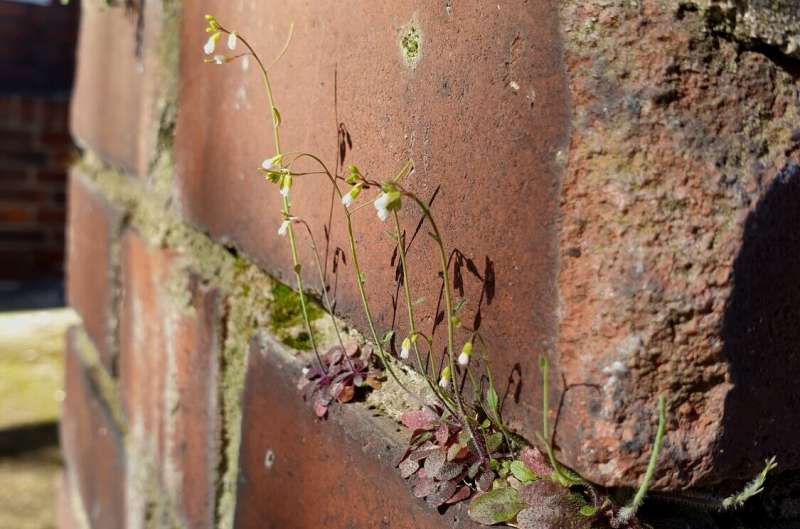This article has been reviewed according to Science X's editorial process and policies. Editors have highlighted the following attributes while ensuring the content's credibility:
fact-checked
peer-reviewed publication
trusted source
proofread
Study finds plant populations in Cologne are adapted to their urban environments

A research team from the Universities of Cologne and Potsdam and the Max Planck Institute for Plant Breeding Research has found that the regional lines of the thale cress (Arabidopsis thaliana), a small ruderal plant which populates the streets of Cologne, vary greatly in typical life cycle characteristics, such as the regulation of flowering and germination. This allows them to adapt their reproduction to local environmental conditions such as temperature and human disturbances.
The researchers from Collaborative Research Center / Transregio 341 "Plant Ecological Genetics" found that environmental conditions filter out unsuited lines from a pool of regionally diverse plant lines, so that only the ones with suitable traits manage to survive.
"This process, termed 'environmental filtering', is well-known for driving the establishment or persistence of plant species in a particular location. It is fascinating to see that exactly the same process also works for different lines within a species," says Anja Linstädter, who has recently left Cologne to become Professor in Biodiversity Research at the University of Potsdam. The study is reported in the article "Environmental filtering of life-history trait diversity in urban populations of Arabidopsis thaliana," published in the Journal of Ecology.
Arabidopsis thaliana is the most common model organism in plant research, and therefore important for plant biology. Most of the research work on A. thaliana focuses on the descendants of a single individual, a line called Col-0, while the naturally growing plants in the region of Cologne show a multiplicity of lines.
"In our research consortium, we work on understanding how findings made in the lab manifest in nature", explained Professor Dr. Juliette de Meaux, spokesperson of CRC TRR 341. "At the beginning, what we asked ourselves is: does the lab line Col-0 resemble lines present naturally in Cologne? But then, we began to realize how much ecological diversity there is in our streets."
The plants analyzed in this study were collected by Dr. Gregor Schmitz, the first author of the study, along his way to work. He noticed that A. thaliana was growing naturally in places with very different environmental conditions. These included patches with little water and nutrient supply such as small pavement cracks, but also highly disturbed habitats. When the scientists sequenced the plant genomes, they found that the urban lines were not more related to each other than to lines from a larger region.
To their surprise, the biologists found that there are large differences among A. thaliana populations in Cologne in respect to their life-cycle traits. These differences contribute to their persistence in habitats that mainly differ in how much they are disturbed by human activities such as weeding or mowing. "In other words, the genetic diversity we find throughout the city is not distributed at random, but matches specific differences in the urban environments," said Schmitz.
Most plants use the cold to regulate the timing of flowering. In this way, they ensure that flowering does not take place in the middle of winter. In the streets of Cologne, the scientists found A. thaliana lines that use cold to regulate flowering, but also lines that do not use it: they flower very quickly after germinating.
Also, the team discovered some lines with seeds that become dormant if they are exposed to high temperatures for a few days alongside lines whose seeds do not become dormant when it is hot.
"The different lines can thus display very different life cycles," said de Meaux. "Some are very fast, they need no dormancy and have no requirement for cold before flowering and others are slower, they have a high capacity to induce dormancy and cold is a requirement to flower. Such diversity across such a small area came as a surprise, but the most admirable was to see that it covaried with the gradient of environmental disturbance in our streets."
The scientists will be further investigating how environmental heterogeneity selects specific genetic variants of urban Arabidopsis thaliana plants in Cologne.
More information: Gregor Schmitz et al, Environmental filtering of life‐history trait diversity in urban populations of Arabidopsis thaliana, Journal of Ecology (2023). DOI: 10.1111/1365-2745.14211
Journal information: Journal of Ecology
Provided by University of Cologne

















